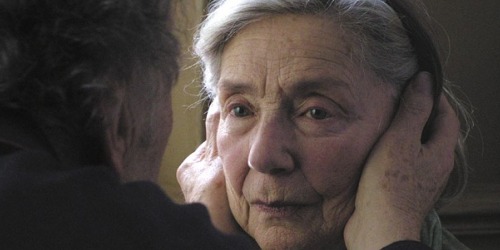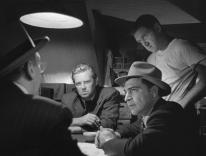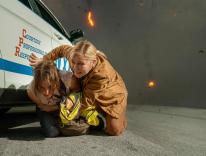
As part of my annual catching up with Oscar, I overcame my reluctance and saw Michael Haneke’s Amour. Haneke’s preoccupation with cruelty, both physical and psychological, typically makes for heavy going, and inclines one to approach any film of his titled “Amour” in the dread expectation of some appalling irony. He’s one of those European directors (Lars von Trier is another) whose achievement is inseparable from the will to torment characters and audience alike; in place of épater la bourgeoisie he proposes massacrer la bourgeoisie, and thus subjects us to a family committing suicide in The Seventh Continent, and to the two-hour nightmare of Funny Games, in which a vacationing couple and their young son are set upon by two posh-seeming young men who knock at the door, asking politely to borrow an egg, then proceed to brutalize the family in a weekend of torture and death. Such cinematic sadism combines with an intense and enigmatic visual style to make Haneke that most problematic of directors: hard to watch, and hard to stop watching.
For me this knotty paradox was untied by his last film, The White Ribbon, a somber study of a village in Germany between the wars that hid its unstated subject—what sort of childhood created Nazis?—inside a meticulous portrayal of profoundly authoritarian family and communal relationships. Muted, dark, and finely observed, it derived its power from an immaculate restraint, à la Robert Bresson, and stirred up a quiet understated dread. It was as if Haneke had finally found his subject; he could stop gratuitously lacerating his characters and explore the pain that was already there. Amour continues this evolution, and in the process does something heretofore unthinkable for this director—expresses love, both between and for its characters. Its title turns out to be gratifyingly non-ironic.
The film’s setup is simple. In a once-grand but now decaying Parisian apartment building, a couple in their eighties, Georges and Anne (French screen titans Jean-Louis Trintignant and Emmanuelle Riva), experience a drastic health setback in the form of Anne’s stroke, and settle in its aftermath into a life of dependence and caretaking. Haneke keeps us entirely inside the apartment, giving us an unimpeded view of the intimacies, indignities, sorrows, and rages that beset a loving couple headed toward death. The claustrophobic quality of the film increases steadily as Georges, overwhelmed and sinking into despair, shuts himself off from all help and contact, brusquely rejecting the overtures of the couple’s daughter, Eva (Isabelle Huppert).
Claustrophobia and despair are not new themes to Haneke. What is new is a recognition that humans can and do treat each other—sometimes over many decades—with tenderness and respect. Where White Ribbon was interested in people as types, and studied them, remorselessly, within a matrix of ideas about history and society, Amour conveys an unexpected readiness to treat Georges and Anne as individuals. They are at once any loving couple facing death and this loving couple. There is nothing gratuitous in what Haneke puts them through, never a moment when either they or we are subjected to anything more than what life—and death—themselves entail.
And that is surely enough. I can’t recall any film, other perhaps than Cristi Puiu’s The Death of Mr. Lazarescu, that portrays dying more comprehensively, with such unsentimental detail. To anyone who has accompanied a loved one through a long death, Amour will be achingly familiar. Through Anne’s suffering Haneke evokes the awful transformation that dying works on those we love—the strange and random callings-out, the hoots and howls of distress; the temporary upticks when the spirit of life returns briefly, bringing lucidity, only to slip away just as quickly. The downward curve is inexorable. “What happens now?” Eva asks in shock after observing her mother’s decline for the first time.
“What happens is more of what has been happening,” he says. “It will get worse, and then it will be over.”
Using the dreariest of colors, Amour paints a vivid portrait of marital love. Kurt Vonnegut, in Mother Night, described marriage as “a nation of two,” and—for better and worse—Georges and Anne’s marriage is just that. They seem very much cut off from others, willingly habituated to each other’s company as exclusive life mates. Their routine depends on a steady exchange of comfortable old jokes and teasing banter, and when this routine begins to break down under the pressure of Anne’s debility, both struggle desperately to prop it up; at one point, with Anne struggling to get words out, Georges leads her through a rendition of “Sur le Pont d’Avignon.” Anne’s physical neediness provokes poignant ironies; when Georges laboriously helps her get from her wheelchair to a living room chair, holding and hugging her as the two take tiny steps in tandem, we realize we are watching a sad simulacrum of a waltz. Amour is full of such heartbreaking moments. Paging through a photo album at the kitchen table, Anne murmurs, “It’s beautiful.” “What?” Georges asks. “Life,” she whispers. “The long life.”
The human story depicted in Amour is obvious and affecting, but the film’s power and intricacy as a work of art are more subtle—hidden, in effect, by the seeming point-by-point factuality with which its anatomy of death proceeds. But Haneke does interesting things with the camera. Long takes from a fixed point of view accent the atmosphere of somber quietude. When a former music student of Anne’s, now a celebrated concert pianist, comes to visit, unaware that Anne is unwell, Georges sits him in the living room while he goes to the bedroom to get Anne. Instead of following Georges, the camera stays on the young visitor, catching him as he waits with vague unease—instinctively nervous in the presence of some unhappiness he doesn’t yet comprehend. In the film’s opening scene, we look out from a stage as a large audience prepares to enjoy a concert. Amid the crowd we note, perhaps, the older couple, her white shirt making a glowing V as the lights go down. It is the one and only time, it turns out, that we will see Georges and Anne out and about in the world.
Haneke’s strength has always been the power to unsettle; and this power, imbued with a new humanism, gives Amour mood combinations that his other films have never aspired to. The scrutiny he applies to human nature is rigorous but forgiving. For Georges and Anne, God is seemingly absent; we sense that art, music, and conversation have been both the currency of this couple’s togetherness and their mutual joy and solace. But art provides solace only so far; after a certain point its beauty, all beauty, becomes unendurable. “Turn the music off,” Anne says curtly, moments after requesting a favorite piano concerto; and when Georges complies, we understand how severely all the rituals and realities that have sustained them in their marriage are threatened by Anne’s approaching death. In one fascinating sequence we dive into a montage of closeups of the landscape portraits that hang everywhere in their apartment, viewing them from ever closer perspectives until we seem to be actually inside the landscapes, as if escaping into a gleaming alternate world.
There is nothing random about these sometimes eccentric choices of perspective and framing. Throughout his film Haneke inserts brief and highly realistic renderings of non-real moments, representing dreams or wish fulfillments, as when Georges pictures Anne at the piano, playing as of old. Taken together, these excursions prepare the way for a carefully composed, mysterious, and deeply satisfying ending. Haneke’s is a realism so austere that all poetry would seem to have been ruthlessly excluded. Yet in the end, Amour makes a surprising move toward metaphor and, perhaps, transcendence, via a closing scene in which Georges and Anne at last manage to escape the apartment that has both sustained and confined them. After long suffering and captivity—and after even longer love—the door opens, and the two inhabitants rise and walk briskly out, leaving only empty rooms.
Please email comments to [email protected] and join the conversation on our Facebook page.
Previous Story
At The Burial of an Abbess
Next Story
Theology & Censorship


